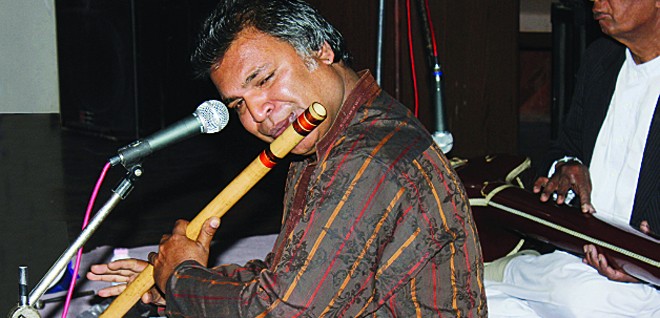

Akmal Qadri and Shahbaz Hussain were two prominent artists at the The Lahore Music Forum’s concert of instrumental music held at the Nairang Galleries last week.
As it is, instrumental music is not heard independently in our society. It does not figure very brightly in the music culture of this region, though instrumental music as an accompaniment is considered to be an integral part of music or musical rendition. Usually a layman thinks that instrumental music is a prelude to real music which for him is vocal rendition. If the instrumental music does not lead to a vocal performance, it is usually seen as an empty experience, half finished and stopped half way to culmination.
In the ancient treatises ,since the human throat was the greatest instrument ever created, instrumental music in our tradition, even in high classical tradition, was placed a notch below that of vocal music or gaiki.
In our history there have been great instrumentalists and the flute is attributed to the gift of Krishen, an incarnation, considered to be the greatest flutist ever. There have been various names mentioned in connection with the veena and pakhawaj but ,despite sporadic examples of greatness, the laurels have finally rested with the vocalists. The current ascendancy of the instrumentalists can be attributed to the colonial encounter and as well as the post-independence recognition of the subcontinental music in the capitals of the world primarily though instrumental music.
For many decades it was the sitar of Ravi Shanker, the sarod of Ali Akbar Khan and the tabla of Allah Rakha that ruled the roost in the West.
Instrumental music created in natural sounds may be on its last legs because now computerised sounds have taken over with their ubiquitous dimension. An instrument was like the extension of the body of a musician, an arm or leg or better still the voice. He lived with it, slept with it and it became synonymous with his self.
In mythology, one comes across legendary characters like Saraswati recognised by the instrument that they played and the magic that they weaved in the process, but now all instruments can be played on the keyboard. It is the computerised, electrically generated sound that may be clinical but very consistent and defies the variations that natural sound is suspect to.
Now as the functional use of natural instruments is becoming rarer their usage in more formal settings too is becoming less. Instead of coping with large numbers of musicians, now only one person can play the keyboard embodying an orchestra, with sounds of as many instruments as desired.
Akmal Qadri has come a long way as a bansuri player. He has now reached a stage where it can be said with certainty that he has matured with the patience and the determination to play the bansuri fully and with great deal of composure. His rendition of raag aimen maintained consistently a certain quality and as he switched to playing a thumri in des it was equally evocative. In all the three principal lais-- the vilampat, mudh and drut -- he was self-contained and did not overstretch either virtuosity or showmanship.
He was accompanied on another bansuri by his son Nazar Abbas whom he has now taken under his tutelage to be an artiste of the future.
He was inspired and tutored by his uncle Sain Allah Ditta Qadri who also played the bansuri with great deal of commitment. For years he was the leading bansuri player in the country playing for his passion at the radio and a few concerts that came his way and for his bread in the films. In some of the compositions of Khursheed Anwar which are known for their bansuri preludes and interludes, Sain Ditta Qadri accompanied vocalists with great sensitivity.
Shahbaz Hussain at present lives in Britain and is one of the thousands of musicians and vocalists who have migrated to greener pastures seeing the plight of classical musicians in the country. He was a shagird of Ustad Shaukat Hussain and has also benefited from the knowledge of great maestros like Fayyaz Hussain and Allah Rakha. Since he lives in the west he has had greater opportunities to mingle with the musicians from the length and breadth of the subcontinent.
In the concert he played gat, rela and qaida in teentaal of his mentors like ustads Ahmed Jan Tharikwa, Fayyay Hussain, Shaukat Hussain and Allah Rakha. He executed the very difficult and complex metrical system with expertise. He had two types of tabla -- one which had a bigger pura, sounding more like the pakhawaj and the other, the normal sized tabla with the regular pura sounding like the tabla that we are familiar with these days. He mixed the various baajs that have gone into the making of his style principally that of Delhi and the Punjab.It was quite delightful to hear a positive outcome of this combination of the traditional and the modern.
It is a good sign that the Lahore Music Forum has continued on the journey of promoting the classical forms of our music. Every year as members of the LMF sit down to decide whether it was worthwhile to pool in their resources, monetary and human, one wonders whether they will continue to do so but the fact that they are continuing for the next year means that they have not given up as yet.